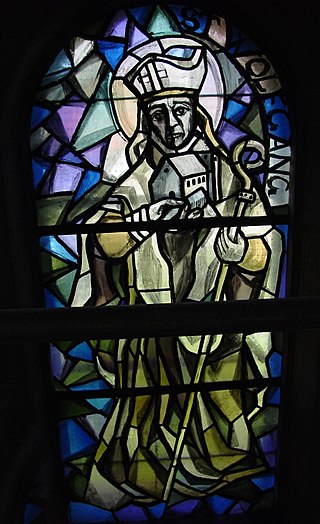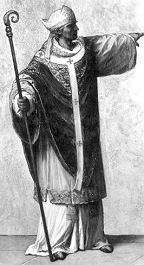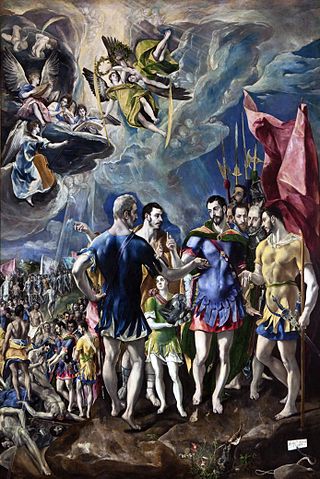Related Research Articles

Pope Agapetus II was the bishop of Rome and ruler of the Papal States from 10 May 946 to his death. A nominee of the princeps of Rome, Alberic II of Spoleto, his pontificate occurred during the period known as the Saeculum obscurum.

Year 954 (CMLIV) was a common year starting on Sunday of the Julian calendar.

Chastre is a French-speaking municipality in Belgium that is located in Wallonia, in the province of Walloon Brabant.

Wolfgang of Regensburg was bishop of Regensburg in Bavaria from Christmas 972 until his death. He is a saint in the Catholic and Eastern Orthodox churches. He is regarded as one of the three great German saints of the 10th century, the other two being Ulrich of Augsburg and Conrad of Constance. Towards the end of his life Wolfgang withdrew as a hermit to a solitary spot, in the Salzkammergut region of Upper Austria. Soon after Wolfgang's death many churches chose him as their patron saint, and various towns were named after him.
Guibert is a given name and surname, and may refer to:

Sigebert or Sigibert of Gembloux was a medieval author, known mainly as a pro-Imperial historian of a universal chronicle, opposed to the expansive papacy of Gregory VII and Pascal II. Early in his life he became a monk in the Benedictine abbey of Gembloux.
Münsterschwarzach Abbey, is a monastery for Benedictine monks in Germany. It is located at the confluence of the rivers Schwarzach and Main in Bavaria.

Saint Blaise Abbey was a Benedictine monastery in the village of St. Blasien in the Black Forest in Baden-Württemberg, Germany.

Notkerof Liège was a Benedictine monk, bishop (972–1008) and first prince-bishop (980–1008) of the Bishopric of Liège.

Gorze Abbey was a Benedictine monastery in Gorze in the present arrondissement of Metz, near Metz in Lorraine. It was prominent as the source of a monastic reform movement in the 930s.

Gembloux Abbey was a Benedictine abbey near Gembloux in the province of Namur, Wallonia, Belgium. Since 1860, its buildings host the University of Liège's Gembloux Agro-Bio Tech faculty and campus.
Saint John of Gorze was a Lorraine-born monk, diplomat, administrator, and monastic reformer.
The Abbey of St. Evre was a Benedictine, later Cluniac, monastery in Toul, France. Established in or just before 507, it was the oldest monastery in Lorraine and of great significance in the monastic and religious reforms in the Rhine and Moselle region of the 10th and 11th centuries.

Exuperius or Exupernis is venerated as a saint and martyr by the Catholic Church; according to tradition, he was the standard-bearer of the Theban Legion and thus a companion to Saint Maurice.

Adalbero I was the bishop of Metz from 929 till 954.
Erluin was a Benedictine monk, the first abbot of Gembloux (946–87) and also briefly the abbot of Lobbes (956–57). Diametrically opposed accounts of his character are given by the partisans of Gembloux and Lobbes.
Heriward was the second abbot of Gembloux from 987. He succeeded his brother, Erluin I.
Erluin II was the third abbot of Gembloux from 991 until his death. He was a nephew of Bishop Erluin of Cambrai and a relative of the first two abbots of Gembloux, Erluin I and Heriward. The Auctarium Gemblacense, a continuation of the chronicle of Sigebert of Gembloux, calls him Erluinus iunior, Erluin the younger.
Ansfried or Ansfrid, was a 10th-century count, who held 15 counties in Lotharingia, a former kingdom which contained the low countries and Lorraine, and which was coming under the control of the new Holy Roman Empire during his lifetime. He is sometimes referred to as "the elder" in order to distinguish him from his nephew, and apparent heir, Bishop Ansfried of Utrecht, who was also a powerful count until he became a bishop.
Guibert of Gembloux was a Benedictine monk who served as secretary to Hildegard of Bingen. He later became abbot of Gembloux Abbey in the province of Namur, Belgium.
References
- ↑ Bormans, Stanislas. "Guibert de Gembloux", Wallonie (SPW), December 2014
- ↑ Charter of Otto from 946 edited and translated by Corpus étampois.
- 1 2 3 Ott, Michael. "Gemblours." The Catholic Encyclopedia Vol. 6. New York: Robert Appleton Company, 1909. 3 December 2022
 This article incorporates text from this source, which is in the public domain .
This article incorporates text from this source, which is in the public domain . - ↑ Michel Lauwers, La Mémoire des ancêtres, le souci des morts. Morts, rites et société au Moyen Âge. Paris Beauchesne, 1997. p.255.
- ↑ "Saint Guibert de Gembloux", Nominis